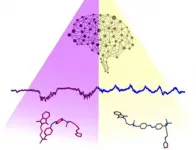Controlling brain states with a ray of light
2021-06-18
(Press-News.org) The brain presents different states depending on the communication between billions of neurons, and this network is the basis of all our perceptions, memories, and behaviours. It is often considered a "black box", with difficult access for clinicians and researchers, as few limited tools are available to perform accurate and spaciotemporal studies on brain neuronal behaviour. Now, researchers from the Institute for Bioengineering of Catalonia (IBEC) in collaboration with August Pi i Sunyer Biomedical Research Institute (IDIBAPS) and have added some light to the subject: they succeeded for the first time in controlling neuronal activity in the brain using a molecule responsive to light.
The study included participants from the Autonomous University of Barcelona (UAB) and was carried out in the frame of the Human Brain Project of the EU. It describes the first way to directly photomodulate brain state transitions in vivo.
The work, led by ICREA Research Professors Pau Gorostiza (IBEC-CERCA, BIST, CIBER-BBN) and Mavi Sanchez-Vives (IDIBAPS) and has been recently published in the journal Advanced Science. Results show that this new molecule, named PAI (for Phthalimide-Azo-Iper) can specifically and locally control the muscarinic cholinergic receptors, that is, the acetylcholine receptors, a brain neurotransmitter very important in several processes as learning attention or memory.
Control of brain states transitions with light
Transitions between brain states, such as going from being asleep to awake, or waking up from a coma, are based on the transmission of chemical and electrical signals among groups of neurons involved in different functions. Current techniques to modulate neuronal activity as transcranial-magnetic or ultrasound stimulation have limitations in spatiotemporal and spectral performance. Another technique with high precision that also uses light to control the neurons in the optogenetics, but it depends on genetic manipulation, making difficult its translation to humans due to safety reasons.
Here, researchers applied photopharmacology to tackle these problems. To do so they used a molecule previously developed at IBEC, PAI, that is light responsive and allows a spatiotemporally controlled modulation of brain neurons, binding and controlling the activity of muscarinic cholinergic receptors, key receptors on neuronal interaction and communication. By using this approach, the cholinergic-innervation dependent brain state transitions can be controlled by light using drugs chemically designed to be photosensitive.
"The control of neuronal activity in the brain is key to perform both basic and applied research, and to develop safe and accurate techniques to perform therapeutic brain interventions in clinical neurology" , explains Fabio Riefolo (IBEC), co-first author of the study.
Changes in brain states
Different brain states and transitions among them are associated with brain function. They are closely linked to changes in brain activation patterns, which in turn reflect the activity and parameters of specific neuronal networks. Thus, manipulation of neurons with a spatiotemporal control is fundamental to determine the relation among brain states and behaviour and to study the influence of neuronal circuits on specific behaviours. In addition, PAI is pharmacologically specific for a muscarinic receptor subtype, M2, which offers exciting prospects to study the pharmacology of brain waves.
When applying PAI to the intact brain, and subsequently white light, researchers could modulate the spontaneous emerging slow oscillations in neuronal circuits and reversibly manipulate the brain oscillatory frequency. This new chemically-engineered tool allowed to induce and investigate in detail, in a controlled and non-invasive way, the transitions of brain from sleep- to awake-like states using direct illumination.
In our brain, neuronal activity is driven by molecules known as neuromodulators, for example acetylcholine (ACh), through their binding to cholinergic receptors. However, it is not completely understood the contribution of the different cells expressing ACh receptors in the global brain behaviour. The use of selective and photoswitchable cholinergic drugs as PAI to achieve a spatiotemporal precise modulation of brain activity opens the way to perform accurate basic neuroscience research and to develop future brain therapies and stimulation.
"The photocontrol of endogenous receptors and their functions in the central nervous system, such as the transition between different brain states, is an achievement for neuromodulation technologies", explains Dr. Almudena Barbero-Castillo (IDIBAPS), co-first author of the study.
INFORMATION:
[Attachments] See images for this press release:

ELSE PRESS RELEASES FROM THIS DATE:
2021-06-18
MADISON - In early January 2021, travelers returning to Tokyo, Japan, from Amazonas, Brazil, were screened for COVID-19 at the airport. A few days later, the National Institute of Infectious Disease of Japan announced that the travelers had returned with a new variant of the SARS-CoV-2 virus.
That variant, known as gamma, or P.1, led to a deadly surge in COVID-19 cases in Brazil this spring, and has now spread across the world. More than 200 cases have been detected in Wisconsin. Whether current vaccines are as effective against the gamma variant remains unknown.
In a new study using variant virus recovered from one of the original travelers, ...
2021-06-18
University of Delaware disaster researcher A.R. Siders said it's time to put all the options on the table when it comes to discussing climate change adaptation.
Managed retreat -- the purposeful movement of people, buildings and other assets from areas vulnerable to hazards -- has often been considered a last resort. But Siders said it can be a powerful tool for expanding the range of possible solutions to cope with rising sea levels, flooding and other climate change effects when used proactively or in combination with other measures.
Siders, a core faculty member in UD's Disaster Research Center, and Katharine J. Mach, associate professor at the University ...
2021-06-17
KIYATEC, Inc. announced today the publication of new peer-reviewed data that establishes clinically meaningful prediction of patient-specific responses to standard of care therapy, prior to treatment, in newly diagnosed glioblastoma (GBM) and other high-grade glioma (HGG) patients. The results, the interim data analysis of the company's 3D-PREDICT clinical study, were published June 16, 2021 in Neuro-Oncology Advances, an open access clinical journal.
A goal of the study, which continues to enroll, was for the test's prospective, patient-specific response prediction to achieve statistical significance for ...
2021-06-17
Researchers from Bentley University, in partnership with Waltham Council on Aging in Massachusetts, and as part of a study funded by the National Science Foundation, have been exploring how the elderly use smart speakers at home. Waltham, a satellite city about eight miles west of Cambridge has a population of about 60,000, with about one in six being an elderly citizen. The purpose of the study was to understand how the elderly use the smart speaker technology at home. A smart speaker is a hardware device that is always-on. When a wake-word triggers the software contained in the device, the smart speaker listens to the command to provide a response or carry out the command (accessing resources ...
2021-06-17
When Ana K. Spalding, a Research Associate at the Smithsonian Tropical Research Institute (STRI) and Assistant Professor of Marine and Coastal Policy at Oregon State University (OSU) talks about mentorship in academia, she describes it as meaningful relationship. It goes beyond conversations about research and publications, and into shared experiences. This is just one approach--proposed by Spalding and 23 other women scientists from around the world, in a new article published in PLOS Biology--that calls for a shift in the value system of science to emphasize a more equal, diverse and inclusive academic culture.
The authors came together after reading a ...
2021-06-17
Superconductors are something like a miracle in the modern world. Their unique property of zero resistance can revolutionize power transmission and transport (e.g., Maglev train). However, most of the conventional superconductors require cooling down to extremely low temperatures that can only be achieved with liquid helium, a rather expensive coolant. Material scientists are now investigating "high-temperature superconductors" (HTSs) that can be cooled to a superconducting state by using the significantly cheaper liquid nitrogen (which has a remarkably higher temperature than liquid helium). ...
2021-06-17
TROY, N.Y. -- Optoelectronic materials that are capable of converting the energy of light into electricity, and electricity into light, have promising applications as light-emitting, energy-harvesting, and sensing technologies. However, devices made of these materials are often plagued by inefficiency, losing significant useful energy as heat. To break the current limits of efficiency, new principles of light-electricity conversion are needed.
For instance, many materials that exhibit efficient optoelectronic properties are constrained by inversion symmetry, a physical property that limits engineers' control of electrons in the material and their options for designing novel or efficient devices. In research published today in Nature ...
2021-06-17
With sorghum poised to become an important crop grown by Pennsylvania farmers, Penn State researchers, in a new study, tested more than 150 germplasm lines of the plant for resistance to a fungus likely to hamper its production.
Sorghum, a close relative to corn, is valuable for yielding human food, animal feed and biofuels. Perhaps its most notable attribute is that the grain it produces is gluten free. Drought resistant and needing a smaller amount of nutrients than corn to thrive, sorghum seems to be a crop that would do well in the Keystone State's ...
2021-06-17
The article 'The RNA Atlas expands the catalog of human non-coding RNAs', published today in Nature Biotechnology, is the result of more than five years of hard work to further unravel the complexity of the human transcriptome. Never before such a comprehensive effort was undertaken to characterize all RNA-molecules in human cells and tissues.
RNAs in all shapes and sizes
Our transcriptome is - analogous to our genome - the sum of all RNA molecules that are transcribed from the DNA strands that make up our genome. However, there's no 1-on-1 relationship with the latter. Firstly, each cell and tissue hasve a unique transcriptomes, with varying RNA production and compositions, including tissue-specific RNAs. Secondly, ...
2021-06-17
Additive manufacturing offers an unprecedented level of design flexibility and expanded functionality, but the quality and process can drastically differ across production machines, according to Hui Yang, a professor of industrial engineering at Penn State. With applications in aerospace, health care and automotive industries with potential for mass customization, additive manufacturing needs quality management.
To address this concern, Yang and a team of researchers from Penn State, University of Nebraska--Lincoln and the National Institute of Standards and Technology (NIST) proposed the design, development and implementation of a new data-driven methodology for quality control in additive manufacturing. They published their work in the Proceedings ...
LAST 30 PRESS RELEASES:
[Press-News.org] Controlling brain states with a ray of light



